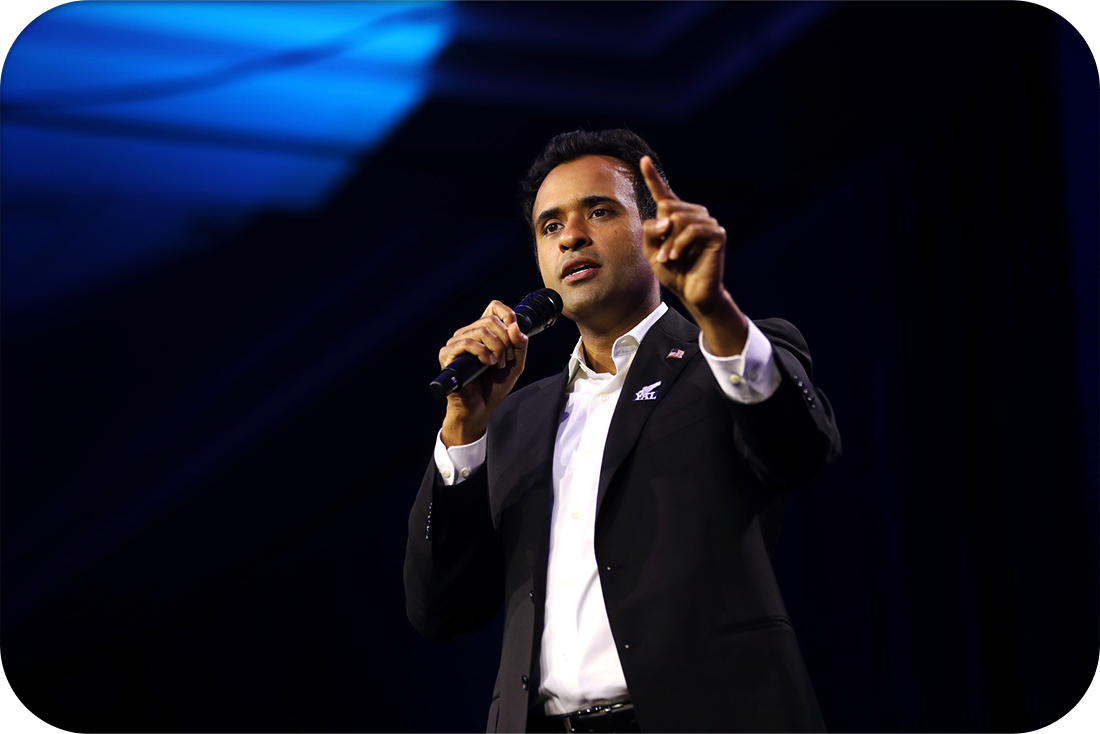Take Aways from H.C. Wainwright Conference: Ramaswamy's Keynote Speech and Anavex Life Sciences (ANVX)
Lickety-Split Analytics
Good morning. Last week we attended the H.C. Wainwright 26th Annual Investment Conference. We have had time to gather our thoughts and wanted to share our takeaways from the event.
Takeaways From Vivek Ramaswamy’s Keynote Address
Vivek Ramaswamy, a biotech entrepreneur turned political candidate delivered a thought-provoking keynote address at the H.C. Wainwright Conference last week.
Vivek Ramaswamy, a Harvard graduate with a bachelor’s in biology and Doctor of Law graduate from Yale, has carved a unique path in business and politics. While introducing himself, Ramaswamy reflected on being an analyst at a hedge fund in New York, where he attended conferences at the Palace Hotel just as the one last week. He later became partner to that hedge fund before founding a rare disease focused biotech company called Riovant Sciences and co-found Strive Asset Management, aligning investment with conservative values. Building on his entrepreneurial success, Ramaswamy launched a bid for the 2024 Republican presidential nomination, where he gained attention for his criticisms for government agencies and vision for a prosperous country.
Ramaswamy began by highlighting the urgent need for increased power generation to support the growing demands of AI. He argued that AI has the power to revolutionize industries such as drug discovery, clinical trial enrollment, hiring, and blockchain, but growth and our competitive advantage is constrained by insufficient energy resources. He expressed how the US burning less coal last year than any time in US history and China burning the most coal last year than anytime in US history gives China a competitive advantage. If we are not to use coal then we have to come up with solutions that combat the opportunity cost. He suggested nuclear energy could be a solution, which is something the NRC regulates, which high regulation is common among many industries in Vivek’s view.
Ramaswamy paused to ask us to look at what impedes innovation.
Ramaswamy delivered critique of federal agencies, stating innovation being stifled traces back “to the three letter agencies… Pick your favorite one: SEC, FTC, FDA, EPA, TSA… Alphabet soup of really people who were never elected to run the government who are actually the ones running the government.”
He emphasized unelected appointees or civil servant like those of the FDA for biopharma is far more impactful on your business over the course of the next four years than who’s even the elected president of the United States. It is an interesting point to reflect upon. Even the FDA commissioner has a political bias, as they are appointed by the president and can be slow to get confirmed by the Senate. We faced this situation in 2021, where we did not have an acting FDA commissioner for three quarters.
Ramaswamy concluded his thoughts on improving agencies by emphasizing the importance of meritocracy. He mentioned the high level of lag in agencies might be more of a detriment to attracting aspiring leaders than the lack of pay, because institutions don’t allow people to achieve their maximum potential with their skill set. He believes people have a hunger to do something bigger than themselves, which reward can be seen more in corporations than government agencies. If we were to implement this type of merit-based culture seen in corporations, cutting out actors and processes that impede this value, our agencies would be more innovative, efficient, and have better leadership.
Ramaswamy expressed concern about the United States subsidizing innovation while other countries free ride on our innovation. Looking at drug pricing, he believes the U.S. subsidizes innovation, causing a portion of the total cost of drug development to rise in our country. Other countries get the benefit that the drugs will eventually end up in their country later on. He wants to ensure other countries are investing and are indeed our allies, which would be a strict improvement, not a tradeoff. A tradeoff would be setting price caps. As a slight tangent, I’ve personally seen a company that delayed European marketing by years because of price caps. If they first get an FDA approval and U.S. market pricing they are able to negotiate a price higher in some ex-US countries, effectively arbitraging their regulation regardless. These kinds of tradeoffs can create supply shortages and shortages to innovation.
Concluding the speech, the commentator questioned, “what’s next for Vivek?” If there is a Trump Vance win, there would be a vacancy in the Ohio Senate (where Vivek lives) that he would consider. He would also take seriously the possibility of running for Governor. He mentioned joining a cabinet position is not something he’s aspired toward but could be a way to serve the country meaningfully. As for the private sector, he alluded to a treatment for a rare disease, not approved because of three letter agencies and not wanting to break too much news today. In my opinion, Ramaswamy could play an interesting role in reforming agencies like the FDA and promoting innovation in healthcare. His experience in the biotech industry and frank criticism of three letter agencies makes him a compelling figure to watch.
Anavex Life Sciences (AVXL)
During a free time slot, I sat in on a presentation I was particularly intrigued by, a CNS focused company called Anavex Life Sciences.
Anavex has a wide base of clinical programs including trials in early Alzheimer’s, Parkinson’s, Rett Syndrome, Fragile X, and Schizophrenia. Their lead clinical program is focused on treating early Alzheimer’s disease which recently presented phase 2b/3 topline data in 338 treatment participants and 170 placebo participants at the end of July. ADAS-Cog13 and ADCS-ALD were the co-primary endpoints of the study. ADAS-Cog13 reached statistical significance at 48 weeks in both 50mg dosing (p=0.021) and 30mg dosing (p=0.026). After 48 weeks, their drug slowed clinical progression by 38.5% and 34.6% for the 50mg and 30mg groups vs placebo, respectively.
The ADCS-ALD endpoint did not reach statistical significance, but did trend positively. This scale is designed to assess functional abilities in more advanced Alzheimer’s and may not be as sensitive in early stage patients. Additionally, there could be a floor effect, where patients with mild cognitive impairment may already be at the low end of the scale, making it difficult to demonstrate improvement.
The secondary endpoint, CDR-SB, is recommended by the FDA as an alternative primary endpoint in early Alzheimer’s and was significant in both dosing groups at 48 weeks.
Adverse events were mostly mild to moderate, including transient dizziness in 35.8% of participants during titration and 25.2% of patients during maintenance compared to 6% and 5.6% respectively in placebo patients. They plan to manage these affects by prescribing at night rather than administering in the morning.
Anavex plans on releasing the full phase 2b/3 data in a peer-reviewed journal and submitting an MAA to the EMA in Q4 2024. The EMA has not approved an Alzheimer’s drug since 2013. They did not approve other Alzheimer’s drugs recently, such as Biogen’s anti-amyloid monoclonal antibody drug that has high ARIA rates, due to the risk of the drug outweighing the benefits. For Anavex’s candidate, this may not be the case and could fulfill a large gap in the European early Alzheimer’s market. We look forward to following the progress of their CNS focused pipeline, especially their early Alzheimer’s treatment.
Share and Subscribe
Want to share this article with someone?
Was this forwarded to you?









